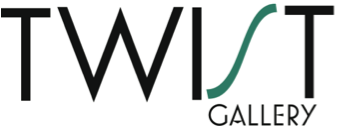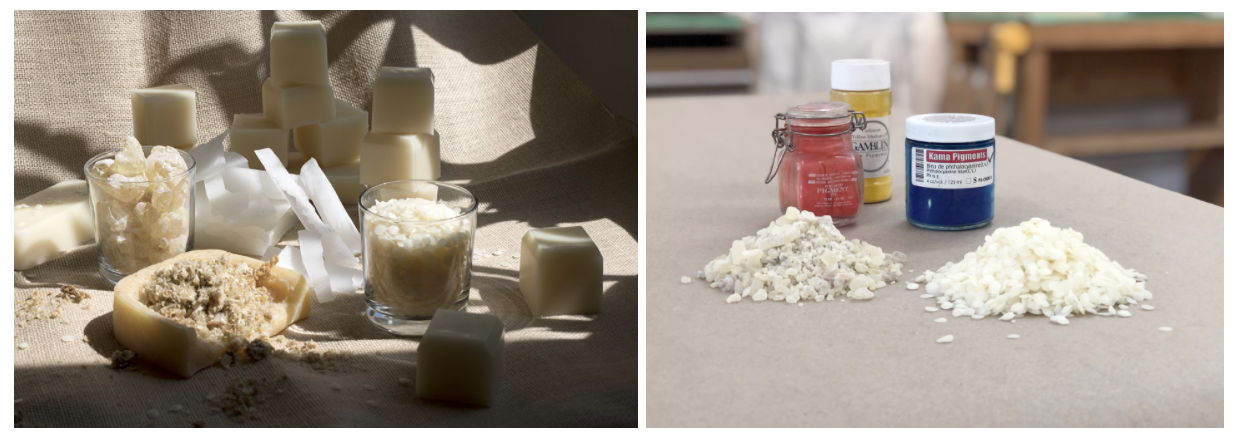This month, Twist Gallery’s Kaleidoscope exhibit features David Brown, an artist who uses the encaustic method for his paintings. David shared images of his work and studio, and taught us all about the encaustic method.
Meet David Brown:
David Brown graduated from the Ontario College of Art and Design University in 1992. He has a 25+ year award winning career in the international art and design industry; honoured by Toronto’s Design Exchange in 1996. David’s work was included in Type Culture, an exhibition of top designers chosen for their pivotal influence on Canadian Typography. David Brown taught Industrial Design at OCADU from 1996 to 2006 while also operating a successful product design studio. David is the founder and managing director of Toronto’s SpeakEasy Events, creating networking opportunities for established and emerging artists since 1996. In 2013 he initiated the Five Star collective aimed at facilitating member participation in international art opportunities which have included Aqua Art Miami, Clio Art Fair and Fountain NYC.
David’s abstract encaustic paintings have been shown at numerous galleries and museums across Canada and the U.S. Recently he mounted a solo exhibition at The Painting Center in Chelsea NYC. His paintings are held in private and corporate collections in North America, Europe and Asia. The products he designed have been sold across North America, and his work has been published in books and magazines throughout Canada and the United States, such as Azure, Canadian Art, Style at Home and The Toronto Star to name a few.
What is the encaustic method?
Encaustic painting is an ancient art form and was practiced by artists as far back as the 5th century B.C.. The word encaustic comes from Greek and means “to burn in”, which refers to the process of fusing the layers of paint together. The technique uses heated wax to which coloured pigments are added. The molten wax is applied to a firm surface–usually prepared wood, paper or canvas.
Encaustic has a long history, but it is as versatile as any 20th century medium. Brushes are used to apply and shape the wax before it cools, then it can be polished to a high gloss; it can be modelled, sculpted, textured, and combined with collage materials. The wax cools immediately, so that there is no drying time, yet it can always be reworked. Encaustic paintings do not have to be varnished or protected by glass.
David painting with wax
“But will it melt on a hot day?”
I get asked this question all the time. The answer is No. The working temperature for the liquid wax is 225 degrees fahrenheit, so unless you are living in an oven the work will be fine hanging in your living room. But, just like any artwork, it is not a good idea to keep it in an area where it will be exposed to direct sunlight or extreme temperatures.
What materials/tools do you need for the encaustic method?
Because the encaustic method is such an ancient technique, it is really very primitive. Basically you need beeswax, some colour, a heat source and a few simple brushes and tools. The Egyptians and Greeks would melt large urns of wax over an open fire and used natural pigments for colour. Today we are blessed with many more modern options. Encaustic paint has become so popular that art supply stores now sell a vast array of both the clear medium and coloured waxes. But I still choose to make my own paint, partly because that is how I learned and partly because I like the alchemy of the process. I use a pharmaceutical grade beeswax, mixed with damar resin (a hard natural resin that comes from a family of deciduous trees that grow in the East Indies), and for colour, I add powdered pigments. I melt the wax on two very large electric skillets in metal tins and baking pans. I apply the wax with natural bristle brushes and I use metal scrapers, knives and sculptor's tools to sculpt and manipulate the paint after it has been applied. I use a plumbers torch, electric iron and a heat gun to “fuse” the wax after each layer has been applied.
The materials I use to make encaustic paint. Bees wax, Damar Resin, Powdered Pigments.
When did you start using the method and why?
I graduated from OCAD in 1992, at that time I had never heard of encaustic paint or the technique. I happened to meet an artist working in the medium and she showed me the basic materials and process and even gave me my first chunk of wax to try out. I went back to my studio and taught myself how to paint with wax. This was before the internet, and before the technique was as popular as it is now. I found a book that was very helpful, but mostly I learned through trial and error. Since then I have fostered an incredible relationship with the encaustic paint and it has become my medium of choice. I often say “the wax and I paint together,” and I truly love this collaboration. The wax has a very strong personality and will usually tell me what it would like to do. There are very defined borders where the wax can not go, but within those boundaries it is extremely flexible. Many painters can't stand working with the encaustic medium because you have to be willing to let go of a certain amount of control. I don't see it that way, I feel like I am learning everyday and that helps to keep the work fresh and exciting.
What influences your art making art practice?
Painting is really just an ongoing series of decisions, one after the other, especially in the kind of work I do. I am an abstract painter. I use a method called encaustic painting. I make my own paint from melted beeswax to which I add ground up pigments. This is a very ancient art form but I use it in a modern context. I draw imagery and inspiration from the people, places and things around me. Life in the urban setting has been a common and ongoing theme that I always return to. I have been told my work seems to have a "Canadian flavour". I take that to mean that I am able to somehow reflect the interesting juxtaposition that we (Canadians) see ourselves living in a vast wilderness, but something like 90% of us live in densely populated urban centers close to the southern boarder. We are an urban society that relates to our vast and wild country. I paint from within, trying to capture the essence of a place, a feeling, or an emotion. I don't plan my pieces, I just build them as I go. I have been working this way for long enough that I trust myself and the process I have developed.
If you’d like to see more of David’s work, you take a look at each piece under artwork showcase or take a virtual walk through our gallery here!






